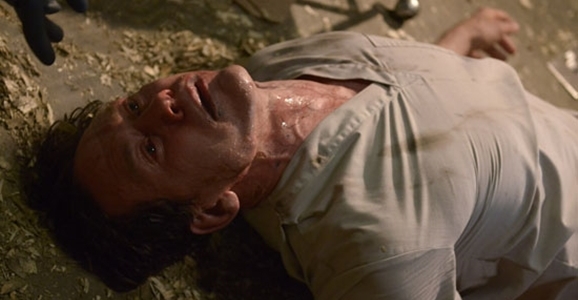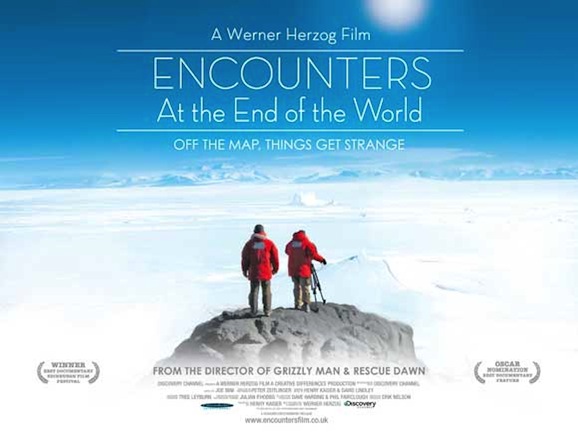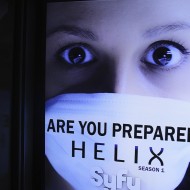Helix Set Visit: A Walk Through Ronald D. Moore’s Arctic-Set Syfy Drama
It may be set in the Arctic Circle, but it's being filmed in Montreal, and we were there.
This article is more than 2 years old
 Ronald D. Moore‘s new show Helix may be set in the Arctic Circle, but the series is being filmed in Montreal, Canada, where some pretty elaborate corridors and labs have been designed to set the scene for the upcoming Syfy drama. I had the opportunity to visit the set of Helix and, in addition to getting to hear from the cast, as well as co-executive producer Cameron Porsandeh and director/executive producer Brad Turner, we were also allowed to snap photos to our heart’s content. So I have a lot to share with you about this little adventure up north.
Ronald D. Moore‘s new show Helix may be set in the Arctic Circle, but the series is being filmed in Montreal, Canada, where some pretty elaborate corridors and labs have been designed to set the scene for the upcoming Syfy drama. I had the opportunity to visit the set of Helix and, in addition to getting to hear from the cast, as well as co-executive producer Cameron Porsandeh and director/executive producer Brad Turner, we were also allowed to snap photos to our heart’s content. So I have a lot to share with you about this little adventure up north.
Syfy’s Digital Press Tour 2013 actually started with a tour of Being Human, and you can read all about that here. We moved on to Helix from there, visiting two separate locations, the first of which is what I’m going to talk about here. But before we get to that, what’s Helix about?
The series is created by Battlestar Galactica‘s Ron Moore and stars Billy Campbell as a doctor who takes his team of CDC scientists to a remote research facility in the Arctic to investigate a potential disease outbreak. Of course, not everything is as it seems, and from what we’re told, “the virus is much bigger than we initially thought.” There’s some kind of second side to it, which is part of this journey for the characters. The setting for the story is present day, and from what Porsandeh told us, all of the science is reality-based:
Everything is rooted in science. That was always very, very important to us. A lot of science fiction is 20, 30, 50 years in the future. We’re really trying to think 3-5 years. Everything is grounded and to the best of our ability, is reflected not only in the dialogue, but everything that you saw on the set tour today, it should all be right.
As for the timeframe of this story, the 13-episode season is just two weeks, with each episode equaling one day…
What I really love about that is you’re going to start our show and end our show in less than two weeks, so those are really the bones of the story and once I had sort of a structure and the story filled out, we brought on Ron Moore. And they said, ‘If you could work with anyone, who would you want to work with?’ and I said Ron Moore, sort of the way a boy says Santa Claus. And they sent it to Ron and he was was gracious and wanted to be involved and what he brought to it, quite masterfully, in my opinion is, he really constructed with me, an overall mythology that not only connects our persons, but connects all the seasons in a really sort of beautiful way that I think is akin to what we saw in Battlestar Galactica, one of the things I really love about that show.
It’s funny that he brings up Battelstar Galactica, not only for the obvious Ron Moore connection, but because there’s a spaceship quality to the set, in that you get the sense of being contained indoors, which is natural considering how cold it’s supposed to be outside. Windows are minimal, though this particular window, which is actually a screen, reminds us of the chilly setting for this series:

The office of Dr. Hiroshi Hitaki (HIroruki Sanada) also had its own window, but we have yet to see what kind of view he has:
We actually didn’t see Hitaki’s facility until later in the tour, but since his office is one of my favorite parts about the set, let’s talk about that for a second. Porsandeh told us that the facility where this story is taking place belongs to Dr. Hitaki, which would explain why he has such a nice office. As you can see, there are a lot of things going on here design-wise, as the office looks like part study, part lab, and part sanctuary for the mysterious character that calls this room his office:
There’s even a sort of rock garden at the entrance with some wooden stairs that give the entryway a sort of outdoor feel. Between that and the plants, you could almost forget that they’re in the Arctic, though I expect that green-screen view at the back of the room will change that a bit.
One curious thing I noticed in Hitaki’s office was this book:
On one hand, there are a number of old-looking things on that table, but this book looks like the kind of prop that would reveal some sort of ancient curse or — for a more scientific theory — perhaps some really old medical research that ties into this mystery virus. That’s just a guess though. As I said, there are some other old-looking things on the desk, and this book could very well just be one more item in Hitaki’s collection.
There are more traditional-looking labs at the facility, including this one, which offers a view of a room where a woman has been quarantined.
Very lifelike, right? It even looked like she was breathing.
Also along the tour, were corridors, more labs, more petri dishes, beakers, microscopes, and other lab equipment than the average person has probably ever seen, at least since high school chem class.



And check out this decontamination room. We were able to walk through while steam blasted at us. On the other side of that door was a room that contained hazmat suits and another smaller room with a decontamination shower.
We also got a glimpse of some of the living quarters…

During the tour, we were told to pay close attention to the duct work. Given the possibly for airborne viruses, the ventilation system could prove to be crucial to the plot in some way. Of course, no details were given there, but there were some pretty elaborate setups, including some ducts that were constructed and set apart from the other sets:


During the panel, which took place later on in the tour, they told us that this facility is occupied by people representing the military, the government, and, of course, scientists. One of the things I was curious about was the chain of command. As I mentioned, this is Hitaki’s facility, but in a place this remote, who’s in charge? What’s the chain of command? Porsandeh describes the setting as the Wild West in a sense, as the authority is kind of unclear…
That’s sort of what I think is the beauty of the show is that the chain of command isn’t very rigid. Dr. Hiroshi Hitaki, it’s his facility. The CDC has a type of jurisdiction. It’s never entirely clear who’s in charge. Yes, you have military people there, with its own agenda as well. If there was a rigid hierarchy, a lot of these processes would move in a more efficient way, but because there isn’t, these characters are at odds with each other. And there’s really no way to enforce the hierarchy regardless. I said this earlier too, but it really is the wild west, in a sense, because even if there were rules, they wouldn’t follow them once the shit hits the fan, and shit is about to hit the fan. So, all rules are off.

Neil Napier, who plays Dr. Peter Farragut — brother to Billy Campbell’s character — brought up Werner Herzog’s Encounters at the End of the World as a film he found particularly interesting in the way it relates to the plot of Helix. “It’s in the Arctic and it follows a bunch of researchers who were pretty well isolated,” he said. “And it was kind of fascinating just to get a bit of insight into their personalities that choose to put themselves in these places and do the work that they do. They’re fascinating people, cool movie.”
Porsandeh added to that, saying that the film was instrumental to the development of the series:
I don’t know how many of you have seen that film, but it was really instrumental in the development of the show too, because what it essentially asks is, what kind of people give up everything they have in the normal world, to fly into the middle of nowhere, just to do research and it’s a very particular kind of character who is game for that and we have 106 people like that in this base.
It’s certainly something to consider when we look at the characters in this show. Not only are many of them there for the science, but they’re also the kind of people willing to head to one of the most remote locations on the planet to do their job.
On the drama side of things, as I mentioned, Napier’s character and Billy Campbell’s are brothers, and it sounds like there’s some bad blood between them, which involves Dr. Julia Walker (Kyra Zagorsky), Alan’s ex-wife. From what Porsandeh says, Julia and Alan’s brother Peter had an affair:
These two gentlemen are brothers and they had a huge falling out, because he was married to her and he slept with her, so an explosion… All of a sudden, they get a distress call that says that Peter is sick and they’re supposed to go back up there together, so these two haven’t really spoken since the affair, and we’re having really the most messed-up family reunion ever, in the most unideal circumstances and that’s really sort of the core of the emotional story. That’s our first triangle and it actually gives way to a second sort of triangle but that’s where we start.
Also among the characters we have Sergio Balleseros (Mark Ghanime), who’s an Army guy. Jordan Hayes plays Dr. Sarah Jordan, a CDC scientist on Alan’s team. Meegwun Fairbrother plays Daniel Aerov, Hitaki’s adopted son and the head of security at the base. If something goes wrong, he’s the guy who takes care of it. And Dr. Doreen Boyle (Catherine Lemieux), a veterinarian and zoologist who works on Alan’s team.
I’m wondering if Dr. Boyle will come into contact with this very scary and lifelike-looking angry monkey we saw among the props.

And speaking of props, here are some more, including a head that looks like it’s been drilled, and a bagged body that looks like it’s seen better days.


We were told that the body is a scientist, though we weren’t told if it’s male or female, nor were we given many clues about the state of it, other than that the scientists are trying to figure out what happened to this person. So it’s possible this poor scientist was one of the first victims of this outbreak.
It sounds like the isolation factor is going to play a big part in how this story plays out, as will the span of time. Porsandeh referenced The Thing when discussing that during the final question of the panel:
It’s an amazing thing to be able to trap characters in this kind of place for 13 days, because all sorts of wonderful things come out. And it almost gets claustrophobic and scary, and we play into all that. But there will be moments when they exit the base, there are things going on in the surrounding area, and yes, we will be introducing a couple characters over the course of the series, but it’s in a way that’s very sort of organic to the story, and that was always the intention. But having said that, this is very much a show that takes place in the Arctic Circle and the same sort of isolation you felt in things like The Thing, those sort of emotional currents are going to be here too and we’re going to exploit them in ways that, quite frankly, a movie can’t because we have a lot longer to play with it and I’m really excited about that.
Helix is expected to premiere January 2014.

























